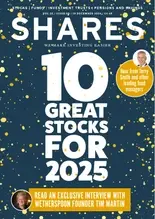
Stocks in London ended Tuesday in the red, as growth fears sparked by the latest US manufacturing data and the weak demand outlook from China weigh on commodity stocks.
The FTSE 100 index closed down 65.38 points, 0.8%, at 8,298.46. The FTSE 250 ended down 171.95 points, 0.8%, at 20,808.56, and the AIM All-Share closed down 4.51 points, 0.6%, at 762.39.
The Cboe UK 100 ended down 0.7% at 830.63, the Cboe UK 250 closed down 1.0% at 18,317.42, but the Cboe Small Companies ended up 0.6% at 16,950.08.
In European equities on Tuesday, the CAC 40 in Paris and the DAX 40 in Frankfurt both declined 0.9%.
In New York at the time of the London close, the Dow Jones Industrial Average was down 1.0%, the S&P 500 was 1.3% lower and the Nasdaq Composite was 2.2% worse off.
Survey data showed the US manufacturing sector continued to deteriorate in August, with reports of factories cutting back on staff amid a slump in new orders.
The S&P Global manufacturing purchasing managers’ index fell to 47.9 points in August from 49.6 in July.
The final reading came in below the flash estimate of 48.0, and represented the most marked deterioration in US factories since the year began.
‘Slower than expected sales are causing warehouses to fill with unsold stock, and a dearth of new orders has prompted factories to cut production for the first time since January. Producers are also reducing payroll numbers for the first time this year and buying fewer inputs amid concerns about excess capacity,’ commented Chris Williamson, S&P Global Market Intelligence’s chief business economist.
Meanwhile, the PMI from the Institute for Supply Chain Management picked up to 47.2 in August from 46.8 in July, suggesting the pace of decline slowed slightly. However, the reading missed FXStreet-cited consensus of 47.5.
The new orders index worsened to 44.6 from 47.4, while the production index fell to 44.8 from 45.9.
‘Demand remains subdued, as companies show an unwillingness to invest in capital and inventory due to current federal monetary policy and election uncertainty. Production execution was down compared to July, putting additional pressure on profitability,’ said ISM committee chair Timothy Fiore.
Thomas Ryan at Capital Economics said the ‘tiny’ rise in the headline index was ‘disappointing’.
Ryan said the figures are consistent with manufacturing output and GDP growth losing momentum in the third quarter, while the sharp drop in the new orders index reduces the likelihood of a turnaround in September.
In London’s FTSE 100, a further drop in oil prices weighed on index heavyweights, BP and Shell, down 3.3% and 2.5% respectively.
Brent oil was quoted at $74.19 a barrel at the London equities close Tuesday down sharply from $76.92 late Monday.
Meanwhile, mining stocks Glencore, Anglo American and Antofagasta fell 4.2%, 4.8% and 5.4% respectively.
Kathleen Brooks, research director at XTB said the commodity price sell off is ‘gathering pace’.
‘Growth fears and the prospect of Opec+ production cuts are weighing on commodity prices, and there are other steep declines across the commodity spectrum today, including gasoline, iron ore futures and copper,’ Brooks noted.
Goldman Sachs cut its copper forecast citing shrinking demand in China.
‘China data this summer suggest weakening cyclical support to commodity demand, and to oil/copper in particular,’ the investment bank said.
The bank now expects copper prices to average $10,100 next year, compared with a previous target of $15,000, thanks to softer-than-expected commodities demand in China as well as a disappointing economic recovery in the country.
The bank also downgraded its 2025 price prediction for aluminium and maintained bearish views on iron ore and nickel.
Goldman’s preferred commodity play is gold.
‘It remains our preferred hedge against geopolitical and financial risks, with added support from imminent Fed rate cuts and ongoing [emerging market] central bank buying,’ the bank stated.
Gold was quoted at $2,482.65 an ounce, down against $2,500.29.
Ashtead Group rose 1.0%.
For the first quarter ended July 31, the equipment rental company posted pretax profit of $544 million, down 7% from $585 million a year prior.
Revenue, however, was up 2% to $2.75 billion from $2.70 billion, while rental revenue rose 7% to $2.54 billion from $2.38 billion.
Ashtead expects full-year rental revenue to grow between 5% and 8%, with capital expenditure between $3.0 billion to $3.3 billion.
‘While the three-month period could hardly be characterised as stellar, the equipment hire company is sticking with its full-year forecasts. Ashtead has been able to eke out some growth and the hit to profit is largely linked to lower levels of used equipment sales, which is not its core business,’ said AJ Bell’s Russ Mould.
In the FTSE 250, Watches of Switzerland rose 6.3%.
The group said that it remains on track to deliver on its annual guidance, after trading in the first 18 weeks of the financial year was ‘in line’ with expectations.
Demand for key luxury brands, particularly products on Registration of Interest lists, remains strong in both the UK and US markets, the firm said, outstripping supply, with consistent additions and conversions. US growth is still expected to be second-half weighted.
The Leicester, England-based watch retailer said it was seeing continued stabilisation of the UK market in both luxury watches and jewellery after challenging macroeconomic conditions in the prior year.
Further, following the acquisition in May, the integration of Roberto Coin is progressing to plan.
Clive Black, retail analyst at Shore Capital, noted that Watches of Switzerland has had a torrid past twelve months, with big earnings misses at the turn of the year set against especially weak UK luxury demand.
Hence, he felt a trading statement that speaks of financial 2025 going to plan ‘should in the big scheme of things reassure’.
On AIM, Craneware gained 7.7%.
The Edinburgh-based provider of software solutions promised another positive year after delivering full-year results ahead of expectations.
In the financial year that ended June 30, pretax profit increased 20% to $15.7 million from $13.1 million a year prior. Adjusted earnings before interest, tax, deprecation and amortisation rose 6.2% to $58.3 million from $54.9 million, ahead of previous guidance of $58 million. Revenue rose 8.8% to $189.3 million from $174.0 million, compared with previous guidance of at least $188 million.
By contrast, First Property Group lost 11%.
The London-based investor and property fund manager’s shares fell after it announced an open offer to raise just under £3.0 million before expenses, through the issue of 37.0 million shares at 8 pence each.
The pound was quoted at $1.3089 at the London equities close Tuesday, softer compared to $1.3145 at the close on Monday. Against the yen, the dollar was trading at JP¥145.85, down compared to JP¥146.95.
The euro stood at $1.1037, down against $1.1068.
Wednesday’s corporate diary sees full-year results from housebuilder Barratt Developments and half-year numbers from car and home insurer Direct Line and asset manager M&G.
The global economic calendar sees a raft of composite PMI readings in Europe, the UK and the US.
Copyright 2024 Alliance News Ltd. All Rights Reserved.




